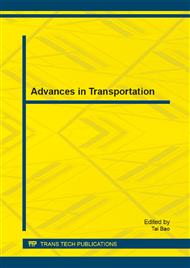p.77
p.82
p.89
p.97
p.102
p.106
p.111
p.117
p.121
Analysis Interlayer Shear Stress of Ultra-Thin Wearing Course Considering Temperature and Different Interlayer Contact Conditions
Abstract:
The paper studies that temperature and different interlayer contact conditions between ultra-thin wearing course and original pavement have an impact on interlayer shear stress. Calculate parameters of each layer asphalt mixture materials under different temperature through empirical formula. Substitute the parameters into BISAR3.0 software to calculate maximum interlayer shearing stress of ultra-thin wearing course under different temperature and interlayer contact conditions. The results show that interlayer contact conditions and temperature have a great influence on interlayer shearing stress of ultra-thin wearing course.
Info:
Periodical:
Pages:
102-105
Citation:
Online since:
January 2014
Authors:
Price:
Сopyright:
© 2014 Trans Tech Publications Ltd. All Rights Reserved
Share:
Citation:


